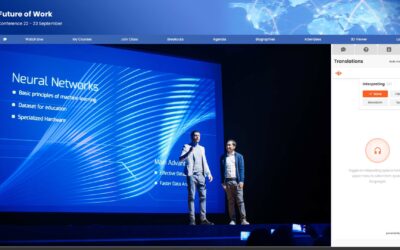Why is interactivity important in online training?
The increased demand of online learning brings with it high expectations of learners and educators alike. Boring, one-dimensional online learning is a thing of the past. Online learners have come to expect, and demand, engaging interactive online training experiences.
The good news? There are masses of opportunities to create engaging and interactive online training experiences and it’s not as complicated as it may sound. Here are some excellent ways to include interactive elements into your next online training programme.
Incorporate interactivity into everything
For online training that is delivered live, in each slide or piece of content, include an interactive element. To create fully engaged and active learners devise your content so that it challenges your learners to engage and feedback at regular points throughout.
According to Scolastic, “interactive learning sharpens critical thinking skills, which are fundamental to the development of analytic reasoning.”
Anything that requires learners to act encourages active learning. This might be a quick fire quiz, a poll, asking learners to make a comment in the chat or even asking them to speak to camera as they would if they were in a classroom.

Competition & leaderboards
It has regularly been argued that competition has a motivational effect on students. Online training should aim to make students do their very best, not simply ‘just enough’. Adding interactive, competitive elements to online training promotes not only competition, but can dramatically boost performance. Leaderboards are both interactive and competitive and can be adopted in many types of online training.
Immersive 360° environments & storytelling
Immersive learning allows the learner to control their own experience. 360 media is at the heart of this, as is digital storytelling. This type of learning evokes emotions so is very influential!
Create a fully immersive 360 environment that puts learners right at the centre of the story. Creating an interactive virtual location is a powerful way to engage learners like never before.
Learners are welcomed into an exciting virtual environment (a conference centre, a famous landmark, a jungle or even space!) and can navigate throughout the environment at their own pace, and in their own way.
A map, personalised video introductions and instructional videos will allow learners to follow their own path through the environment accessing various elements of the training as they go. This training can combine many types of interactive content to keep it interesting and relevant. Examples include pre-recorded videos, webinars, live streams, video tours, whiteboard sessions and integration with common Learning Management Systems like Articulate.
The beauty of a virtual environment is that it can also include interactive elements such as scavenger hunts and fact-finding missions that contribute to leaderboard results. As we know, adding an element of peer to peer competition and team collaboration can be hugely beneficial for online learner outcomes.

Videos for online training
Interactive videos keep online training interesting. Virtual tours can be an excellent way to educate leaners online, helping them to become familiar with a certain place, practice, process or workplace. Videos are a great way of conveying a specific organisational culture which is particularly useful for onboarding.
Virtual training simulations
Virtual training centres are a fantastic way of including interactivity within your online training. A virtual training centre can host, within it, demonstrations of systems, software, equipment and procedures in a 360 virtual format. Takeaway materials can then be made available such as downloads, surveys and feedback forms.

Gamification
Adding gaming elements to online training is a simple way to support learners to learn, but in a way that doesn’t feel dry or tedious. Some examples where this has been used successfully include action based content unlocking, progress based passports, scavenger hunts, tap into competitions, timed quizzes, physical and mental challenges and leaderboards.
Integrations
Developing a more successful training experience is made even easier by integrating existing platforms and services within your new campaign. For example, you may have a set of pre-learning materials already created, or want to utilise a Miro board – these can simply be made available as part of a 360 immersive experience. Any LMS already created can also be integrated, leveraging existing training programmes and creating a fresh and exciting experience for learners.
In summary
Interactive training requires participation and challenges learners to manage their own learning progress in an active way. With interactive elements that are based on real life scenarios, learners are empowered to get involved in real life decision making and problem solving.
This type of learning is not only fun and allows learners to discover for themselves, but also allows them to put their knowledge into action. This approach to training boosts critical and creative thinking skills and is fun and sparks motivation.
What more could you ask for? For more information on how Procreation can help you create interactive online training get in touch today or book a demo.
Book a time with one of our team to discuss your next project
More insights from the Procreation blog
Procreation and Interprefy partnership
Procreation are delighted to announce their new...
Unmissable features for Virtual Events: Network Café
Virtual Event Feature spotlight - Networking...
Gen Z in the workplace: what you need to know
Gen Z – the next generation of workers Gen Z is...




